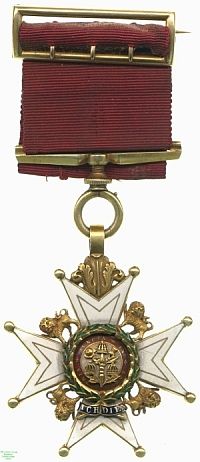
Obverse, a gold sceptre with a rose, a thistle and a shamrock sprouting therefrom, all on white enamel encircled by an inscription in gilt on a red enamel and gold wreathed border in green enamel, all on a Maltese Cross of eight points enamelled in white with grey lining, the second inscription in gilt on a blue enamelled banner to the lowest arm; a gold pearl to each point and a gold lion passant-guardant in each angle of the cross, the whole surmounted by plumes to which the suspension is attached

Reverse, a gold sceptre with a rose, a thistle and a shamrock sprouting therefrom all on white enamel encircled by an inscription in gilt on a red enamel and gold wreathed border in green enamel, all on a Maltese Cross of eight points enamelled in white with grey lining, the second inscription in gilt on a blue enamelled banner to the lowest arm; a gold pearl to each point and a gold lion passant-guardant in each angle of the cross, the whole surmounted by plumes to which the suspension is attached